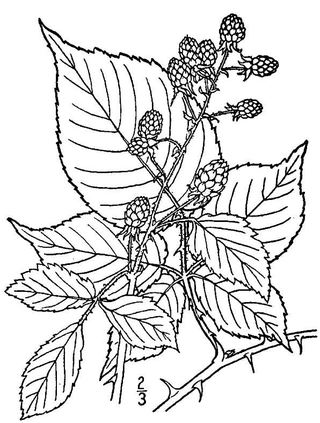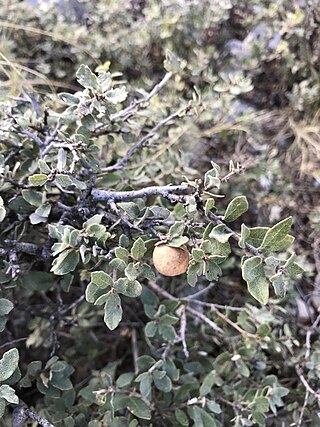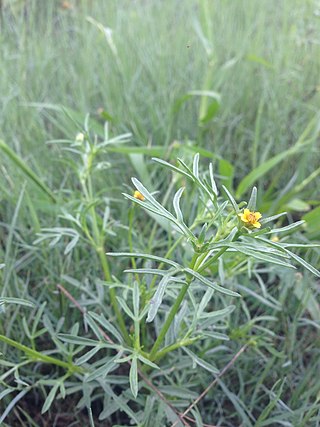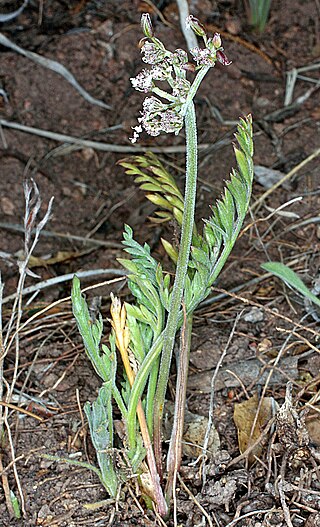
Harperella is a monotypic genus of flowering plants in the family Apiaceae. Its only species is Harperella nodosa, known as piedmont mock bishopweed and harperella. It is native to riparian environments in the Southeastern United States, found at sites in West Virginia, Maryland, several Southeastern states such as Alabama and North Carolina, and the Ouachita National Forest in Arkansas and Oklahoma. As Ptilimnium nodosum, it was placed on the United States' Endangered Species List in 1988.

Per Axel Rydberg was a Swedish-born, American botanist who was the first curator of the New York Botanical Garden Herbarium.

George Vasey was an English-born American botanist who collected a lot in Illinois before integrating the United States Department of Agriculture (USDA), where he became Chief Botanist and curator of the greatly expanded National Herbarium.

Gutierrezia microcephala is a species of flowering plant in the family Asteraceae known by the common names sticky snakeweed, threadleaf snakeweed, threadleaf broomweed, and smallhead snakeweed. It is a subshrub native to the southwestern United States and northern Mexico, and can be found in arid grassland and desert sand dune habitats. It can be toxic to livestock in large quantities, due to the presence of saponins and high concentrations of selenium.

Sedella is a small genus of annual flowering plants in the family Crassulaceae. There are approximately 7 species, all native to California, United States, one with a distribution extending into Oregon. These are petite succulent plants growing a few centimeters tall and bearing tiny yellowish or brownish flowers. Mock stonecrop is a common name for these plants.
Tumamoca macdougalii Rose is a member of the Cucurbitaceae or gourd family. Also called the Tumamoc globeberry, it is native to a very narrow area of the Sonoran Desert, and is found in both Sonora and Arizona. It is one of two species in genus Tumamoca.

Vernon Orlando Bailey (1864–1942) was an American naturalist who specialized in mammalogy. He was employed by the Bureau of Biological Survey, United States Department of Agriculture (USDA). His contributions to the Bureau of Biological Survey numbered roughly 13,000 specimens including many new species. Bailey published 244 monographs and articles during his career with the USDA, and is best known for his biological surveys of Texas, New Mexico, North Dakota, and Oregon.
Gutierrezia texana is a North American species of flowering plant in the family Asteraceae known by the common name Texas snakeweed. It is native to the south-central United States and northern Mexico as far south as Guanajuato and Hidalgo.

Rubus allegheniensis is a North American species of highbush blackberry in Section Alleghenienses of the genus Rubus, a member of the rose family. It is the most common and widespread highbush blackberry in eastern and central North America. It is commonly known as Allegheny blackberry.
Prionosciadium linearifolium is a plant known from the Mexican states of Puebla and Zacatecas. It is a biennial herb with compound leaves with long linear leaflets.

Quercus intricata, common name dwarf oak, intricate oak or Coahuila scrub oak, is a plant species native to northern Mexico and western Texas.
Iresine heterophylla, or Standley's bloodleaf, is a plant species native to the southwestern United States and also to Mexico. It has been collected from Arizona, New Mexico, Texas, Chihuahua, Sonora, Durango, Coahuila, Nuevo León, Campeche and Tabasco.
Brickellia hebecarpa is a Mexican species of flowering plants in the family Asteraceae. It is native to western Mexico, the states of Colima, Michoacán, and Jalisco.
Gutierrezia petradoria is a species of flowering plant in the family Asteraceae known by the common names San Pedro snakeweed and goldenrod snakeweed
Gutierrezia wrightii is a North American species of flowering plant in the family Asteraceae known by the common name Wright's snakeweed. It is native to the southwestern United States and northwestern Mexico.

Heterosperma pinnatum, the wingpetal, is a New World species of plants in the sunflower family. It has a discontinuous distribution in North and South America, having been found in Bolivia, Venezuela, Mexico, Guatemala, Honduras, and the south-western United States,
Hymenopappus radiatus, the ray hymenopappus, is a North American species of flowering plant in the daisy family.
Effie Almira Southworth Spalding (1860–1947), was an American botanist and mycologist, and the first woman plant pathologist hired by the United States Department of Agriculture (USDA). Her most important discovery was the 1887 identification of the fungus Colletotrichum gossypii as the cause of cotton cankers, a disease which killed thousands of acres of cotton and was a major economic threat. She taught botany at several institutions, worked at the Desert Botanical Laboratory with her husband, and established the Botany Department Herbarium at the University of Southern California.

Myrtillocactus cochal, the cochal or candelabra cactus, is a species of flowering plant in the family Cactaceae, native to the Baja California peninsula. Individuals can reach 3 m (10 ft), and are hardy to USDA zone 9b.

Lomatium orientale, commonly known as salt-and-pepper, eastern cous, eastern desert-parsley, eastern lomatium, white-flowered desert-parsley, oriental desert parsley or Northern Idaho biscuitroot, is a small spring blooming ephemeral plant. It grows in open habitats from the plains to foothills in western North America. It is known as one of the earliest blooming native flowers in its habitat. The species name, "orientale", is botanical Latin meaning "eastern".











